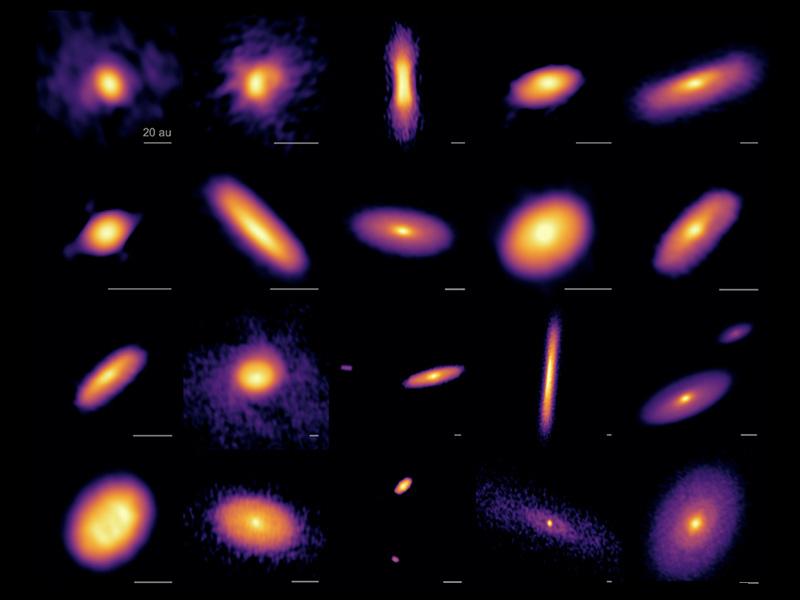Astronomers Dig Deeper into Mystery of Planet Formation

The quest to identify the origins of our solar system and the planetary systems outside it drives many of the most high-profile efforts by contemporary astronomers. Recently, an international research team, featuring a University of Virginia astronomer and graduate student, used observations from the Atacama Large Millimeter/submillimeter Array (ALMA), an international astronomy facility in Chile, to advance the search for the earliest signs of planet formation.
Their survey, titled "Early Planet Formation in Embedded Disks (eDisk)," was motivated by recent findings that planet formation may be well underway in the more-evolved “protoplanetary” disks of material formed around young stars that have been studied with ALMA. There had been no systematic study to search for signs of planet formation in the younger “protostellar” systems until the efforts of UVA astronomy professor Zhi-Yun Li and Ph.D. student Zhe-Yu Daniel Lin as part of the international team led by Nagayoshi Ohashi of Taiwan’s Academia Sinica Institute of Astronomy and Astrophysics.
"We caught the disks surrounding the newborn stars early enough that the tiny dust grains – the raw material for building planets – have yet to be pulled by gravity towards the disk mid-plane to kick-start the planet formation process,” Li said.
The initial results of their research are detailed in a series of 18 articles, including five published or scheduled for publication in The Astrophysical Journal. (The first four were published on June 27.)
The building blocks of planets
Planets form in a disk around a young star. These disks endure at most a few million years, which means that a forming planetary system has only this amount of time to finish its formation. However, it is still not clear just how rapidly planet formation begins within these disks. Recent ALMA observations revealed that many protoplanetary disks have substructures such as gaps and rings, and astronomers believe these gaps and rings are strong evidence that planets are already forming or are almost completed in such relatively evolved systems. But it leaves open the question: at what stage of star formation does a planet start to form?
Enter Ohashi and the international team featuring UVA’s Prof. Li and graduate student Lin. Their project focused on disks around 19 protostars, systems that are only 10,000 to 100,000 years old. The international team, featuring 37 researchers from 15 research institutes and universities, observed via ALMA the radio emissions from dust grains in the disks that serve as the building blocks of planets.

The 19 protostars observed by this project are located within about 650 light-years of Earth, said Lin, a rising sixth-year UVA Ph.D. student in the College and Graduate School of Arts & Sciences’ Department of Astronomy. (About half of the project’s research groups are graduate students like Lin or young researchers who have recently completed their doctorates.)
Previous studies observed only a small handful of protostars with the resolution necessary to detect signs of planet formation. Thanks to ALMA’s capabilities, they were able to examine the protostellar disks as part of the first systematic study to investigate the detailed structure of disks around a large sample of protostars with such a high angular resolution.
“The younger protostellar disks are better systems for us to understand what sort of environments planets are starting to form in,” Lin said. “Hopefully by studying these systems we can understand the whole diversity of exoplanets.”
Their observations confirmed that there are disks around all the protostars, meaning that the minimum conditions for planet formation are already present in these young protostar systems. However, the observations also clearly show that the disks around protostars are different from more-evolved protoplanetary disks. Among the 19 protostars, the rings and gaps serving as signs of planet formation were observed in only a few of the disks. Moreover, the ring structures are less distinct than those seen in the protoplanetary disks.
The team also found that the dust grains are not settled to the disk midplane. Instead, they are aloft above the disk midplane, making the disks appear thick in the vertical direction. In more-evolved disks, in contrast, the dust settles down in the midplane, making them appear much thinner.
Ohashi said they did not expect to see such clear differences between disks around protostars and more-evolved disks. John Tobin, a co-principal investigator of the program at the National Radio Astronomical Observatory, said their results “suggest that disks around protostars are not fully ready for planet formation.”
A larger question remains worth further research, Lin added. When exactly does planet formation begin, and how long does it take to complete?
“Our new data suggest that planets typically do not start to form in earnest right from the very beginning of star formation,” Lin said. “Instead, their formation appears to kick into high gear during the transition from the early protostellar stage of star formation to the later protoplanetary stage.
“Further exploration is needed to narrow down the exact timing of the planet formation process.”
About ALMA
The Atacama Large Millimeter/submillimeter Array (ALMA), an international astronomy facility, is a partnership of the European Organisation for Astronomical Research in the Southern Hemisphere (ESO), the U.S. National Science Foundation (NSF) and the National Institutes of Natural Sciences (NINS) of Japan in cooperation with the Republic of Chile. ALMA is funded by ESO on behalf of its Member States, by NSF in cooperation with the National Research Council of Canada (NRC) and the National Science and Technology Council (NSTC) in Taiwan and by NINS in cooperation with the Academia Sinica (AS) in Taiwan and the Korea Astronomy and Space Science Institute (KASI).








